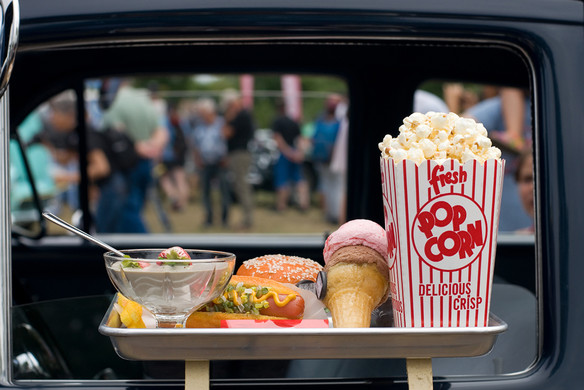Table of contents
With social distancing now being a necessity, restaurants, movie theaters, retailers, and other experiences that rely on in-person seating have looked for creative ways to bring in customers safely. Cars, which can acts as personal pods away separating patrons into their own spaces, are an accessible way to practice safety guidelines. .
Curbside pickup has grown in response to this trend, with an increase in usage by more than 200 percent from April 2019 to April 2020, according to Adobe.
But incorporating cars can go beyond delivery pickup. In fact, in an effort to maintain the feeling of in-person customer experiences, businesses have started to leverage a little bit of nostalgia, bringing back drive-ins and drive-throughs that were popular decades ago and making them fresh again. With everything old starting to become new again, we took a look at the history of drive-ins and drive-thrus, and how they are being remade to engage with modern customers.
Future-proof your restaurant
Stay ahead of industry trends with insights, tools, and strategies from Square’s Future of Restaurants report.
Drive-ins
The first drive-in movie theater was the Park-In Theater in New Jersey, which opened in 1933. In their heyday in the late 1950s, there were 4,000 drive-in theaters across the country. Eventually, large cinemas won the favor of moviegoers, and the current number of drive-in movie theaters is now about 549.
While they didn’t completely go away, the pandemic has brought drive-in movie theaters back into fashion. Many states closed indoor movie theaters or limited occupancy to comply with social distancing guidelines. In response, some local theaters created drive-in movie experiences in their parking lots as a way to pivot their business and remain open. Other businesses and organizations created drive-in movie experiences in large parking lots or fields, including some Walmart locations. Technology has made this entertainment option easier to facilitate by allowing sound to be piped in through a car radio or Bluetooth device.
The drive-in entertainment concept is also being used as a way to host concerts, stand-up comedy shows, plays, and even bingo. A Toronto gallery created an immersive drive-in exhibit called Gogh By Car that accommodates 14 vehicles at a time. The gallery was supposed to open the exhibit in the spring but had to quickly pivot due to the pandemic. The initial run of tickets sold out in about 24 hours.
Drive-in dining is also making a comeback. During the ‘50s, carhop service at drive-in restaurants was a popular type of dining for families as well as teens. While Sonic — a fast-food chain that operates in 46 states — has built its business model around the concept, Mel’s Drive-In and Bob’s Big Boys have brought back the service in California, providing the option for those who want to dine outside in their cars. At Mel’s Drive-In, you park in the lot, call in your order, and wait for the carhop to deliver it to your car. At Bob’s Big Boy, customers order at the drive-thru window, park under an awning, and the food is brought out by a carhop.
Drive-thrus
In the 1940s, a few restaurants started to offer a drive-thru service. However, In-N-Out Burger in California is credited as being the first to offer the complete service with an intercom system and no indoor dining space or parking lot. Since then, most fast-food restaurants added a drive-thru to its operation, and businesses such as banks or pharmacies also built drive-through service as part of its customer convenience.
While a drive-in involves the customer parking and enjoying the show or meal, a drive-thru keeps the action moving. Today, however, the drive-thru is being used to create immersive experiences that also entertain customers from a distance. For example, the hospitality tech platform Resy reinvented the traditional drive-thru dining experience by sponsoring a drive-thru 10-course dining eventin Los Angeles, featuring some of the area’s best chefs and restaurants. Customers got to experience a progressive dinner from the safety of their vehicles.
An art gallery in Brazil, for example, created a drive-thru exhibit built in a shed with QR codes that visitors can scan to get audios that explain the works as they move through the circuit. The Richmond Raceway Complex created Jurassic Quest Drive-Thru Experience, which features 70 moving, life-like dinosaurs for an exciting family adventure.And zoos across the country are borrowing from the safari model, attracting customers by creating drive-through exhibits with food and beverage options.
Leveraging the trend
Depending on your business, a drive-thru or drive-in strategy could improve your customers’ experiences with your brand.. While many consumers are feeling safer in their cars, they’re also looking for unique experiences they can do while staying distanced.
Here are a few ideas for giving them what they want by leveraging this nostalgic solution:
Locate drive-thru markets in your area where you can sell your goods. For example, a farmer’s market in North Carolina created a drive-thru shopping experience, where customers browse and buy fresh products from their cars. Find out if there are similar offerings in your area, and how you can become a vendor.
Partner with other businesses that are already doing these types of events. If you sell a product or service that complements a business that is already doing a drive-in or drive-thru event, reach out and see if you can join the fun. For example, food trucks and restaurants are partnering with theaters to offer meals during movies. If you sell snack items, for example, offering to set up a booth at a drive-in art exhibit might make the event more enticing for visitors.
Become a trendsetter. If drive-in or drive-thru experiences have yet to become popular in your area, consider starting one. You could do a drive-thru pop-up shop for the holidays, or drive-in demonstrations for your goods. Or if you provide goods and services to businesses that might be struggling or looking for opportunities, consider creating a platform for them, as Resy did. It’s not only a way to provide an entertaining experience for consumers; it could help you build good business relationships.
Get the technology you need. A lot has changed with technology since drive-in movies and drive-thrus were first introduced. You can leverage QR codes for self-serve ordering and payment straight through your customer’s mobile devices, kiosks, and other contactless options.
Find a holiday tie-in for your drive-in or drive-thru event. For example, during Halloween, drive-thru haunted houses and hayrides popped up in cities and became a popular pastime for families. Drive-thru light displays create a winter wonderland experience that can attract those who want to enjoy holiday festivities while avoiding being in the middle of a crowd. By tying your event to something consumers want to celebrate, you may draw a bigger crowd.
These new types of drive-ins and drive-thru may or may not become permanent fixtures in the market after the pandemic, but what will last are the memories they can create. By being a business that isn’t afraid to pivot and change with the times, you can show your customers that you are willing to adapt to the experiences they are looking for, giving them a refreshed taste of nostalgia in the process.
![]()











